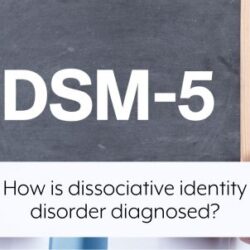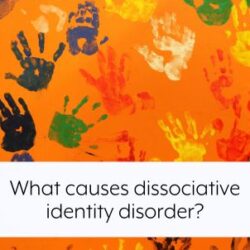
What is dissociative identity disorder?
Dissociative identity disorder (DID) is neither a personality disorder nor a psychosis. It is certainly not the same as schizophrenia, with which it is often mistaken.
DID is simply a creative survival mechanism for coping with overwhelming and chronic childhood trauma.
Is dissociative identity disorder the same as multiple personality disorder?
Its previous name of Multiple Personality Disorder was misleading, as it suggested that in dissociative identity disorder the person has multiple personalities, as if several different people are living in the same body. This may be what it subjectively feels like to many people with DID, but it is not the objective truth. Rather, the personality of the one person is comprised of many ‘parts’ “that are not yet functioning together in a smooth, coordinated and flexible way” (Boon et al, 2011): the one, single person does not have a unitary, single sense of self, but perceives themselves to be multiple. They may also be experienced by others as such, with different ‘parts’ becoming at times quite autonomous and identifying themselves with different names. The ‘parts’ that make up the whole that is a person with dissociative identity disorder may perceive themselves to be of different ages or different genders, and will have in subtle or obvious ways very different ways of perceiving and relating to the world around them. It is therefore easy to see why it is thought of in terms of ‘multiple personality’, but a more accurate rendering is that the person with DID has multiple parts of a single personality, even though it often doesn’t feel this way.
What causes dissociative identity disorder?
Dissociative identity disorder is almost exclusively caused by repeated childhood trauma in the absence of appropriate parental support and is a way of coping with that trauma, rather than being a lifestyle choice or simply a variation of ‘normal’ experience. The personality is experienced in a disconnected way via separate ‘parts’ or ‘alters’ because of conflicts between those parts, and a failure in psychological development to ‘integrate’ or join together the different facets of personality, memory, identity, behaviour and feelings.
Most people achieve a unitary sense of self in the course of normal psychological development, so that as an adult they are aware that they are the same person they were as a child, the same person they are now looking back on being a child, and the same person who exists in all the different roles in life, such as parent, partner, work colleague, friend and family member. Most people can ‘shift gears’ between these different parts of their personality without thinking about it, and retain a single sense of themselves and their identity whilst operating in these different roles. They do not lose a clear sense of “I” either across their different roles in life, or across the lifespan. But someone with dissociative identity disorder may find this much more difficult — they may not have a sense of a thread running between all the different parts of their experience, a single, core sense of “I”. Furthermore they may experience intense conflict between different ‘parts of the personality’ and may experience some degree of amnesia or lack of conscious awareness when ‘switching’ to a different part of themselves.
It is important to realise that the different parts of the personality in dissociative identity disorder usually exist because of this conflict and because of the unbearable intensity of their feelings. A large part of recovery from DID involves resolving these conflicts so that there is no longer any need to remain separate, with knowledge and emotions partitioned off in discrete sections of the mind. This is the essence of ‘integration’ — bringing together parts of the self that have become and remain separate.
What is dissociative identity disorder like?
Although everyone with dissociative identity disorder is unique, often they share certain characteristics with others with DID, and this is especially true in terms of the way that the different parts of the personality are structured. This concept of conflict can be seen at a fundamental level in terms of two main types of parts within a person’s internal ‘architecture’.
There are usually parts who try very hard just to get on with normal life, who want to be seen as normal, participate in family and work life, and do not want to be identified either as mentally ill or as having a history of trauma or abuse. This conflicts hugely with other parts of the personality whose main function or role has been to try to protect the person from the kinds of abuse or trauma that they suffered as a child.
Whilst parts of the personality that do normal life often have little or no memory or acceptance of having been abused as children, trauma-
This basic conflict between two different types of ‘alter’ or ‘parts of the personality’ is described in a theory of the development of dissociative disorders called ‘structural dissociation’, developed by Onno van der Hart, Ellert Nijenhuis and Kathy Steele and expounded in their book The Haunted Self (2006). They refer to two main types of ‘alter’ or ‘parts of the personality’ in dissociative disorders: ANPs (Apparently Normal Personalities) and EPs (Emotional Personalities). ANPs are avoidant of trauma and often phobic of relationships and emotions, whilst the EPs are stuck in so-
Suzette Boon describes dissociation as:
a kind of parallel owning and disowning of experience. While one part of you owns an experience, another part of you does not. Thus, people with dissociative disorders do not feel integrated and instead feel fragmented because they have memories, thoughts, feelings, behaviours and so forth that they experience as uncharacteristic and foreign, as though these do not belong to themselves.
(Boon et al, 2011)
This is what often characterises DID: a simultaneous owning and disowning of the trauma, constant struggles with denial, and a corresponding confusion in identity.
Is dissociative identity disorder always obvious?
Dissociative identity disorder can often be bewildering to both the person who has it, and people around them. It does at times present dramatically, with switches between parts of the personality being very obvious and quite disconcerting, especially to people who do not understand the reasons for it or the way in which the dissociative mind is structured. However, Richard Kluft emphasises that dramatic presentations of dissociative identity disorder are the exception rather than the rule. He argues that “only 6% make their DID obvious on an ongoing basis” (Kluft, 2009, p.600). Elizabeth Howell similarly refers to DID as “a disorder of hiddenness” (Howell, 2011, p.148) and there is growing consensus that the representation of dissociative identity disorder in media portrayals such as Sybil is a caricature that is not based on the real experiences of the majority of people with DID. Most in fact do their best to hide their symptoms, in accordance with the function of the ‘apparently normal’ (ANP) parts of themselves, which is to avoid reminders of the trauma, as well as other parts of the personality. In a society in which there still remains huge stigma and discrimination for having any form of mental illness, overtly demonstrating the dissociative parts of one’s personality is arguably ‘maladaptive’ as it often leads to rejection, shame and mockery.
People with dissociative identity disorder exist on a huge spectrum. Some are able, at least most of the time, to maintain both a family and work life and may even do so brilliantly. Others are severely disabled by their condition and in the absence of adequate treatment have little or no control over the trauma-
What is the outlook for dissociative identity disorder?
There is however a very positive prognosis for people with dissociative identity disorder. With the right treatment — which is generally held to be long-
More information
http://www.nhs.uk/Conditions/dissociative-disorders/Pages/Introduction.aspx
http://patient.info/health/an-introduction-to-dissociative-identity-disorder


